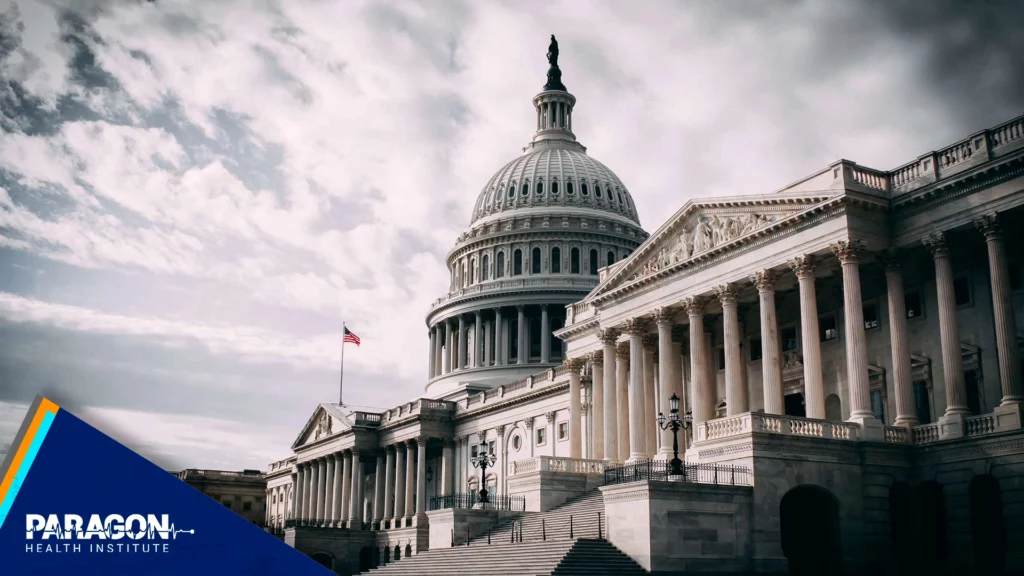Dear Chairman Hern, Representative Allen, and Representative Spartz:
My name is Brian Blase. From 2017-2019, I served as a special assistant to President Trump at the White House’s National Economic Council. Before, during, and after my time in the White House, my professional focus has been on health policy reform, specifically how to address problems in government programs and increase the value Americans receive from our substantial amounts of health spending. Of note, from 2011-2014, I was a senior professional staff member at the House Committee on Oversight and Government Reform. In 2014 and 2015, I served as the health policy analyst at the Senate Republican Policy Committee.
In a few weeks, I will launch a new think tank, the Paragon Health Institute, that will focus on consumer-driven health reform solutions at both the federal and state levels. I appreciate the opportunity to be with you today. I have written a brief statement, and I am happy to elaborate on any of the issues I raise with you today or in the future. My testimony is about providing market oriented solutions to the problems of high health care costs.
My recommendations are divided into six areas: 1) empowering consumers financially, 2) promoting consumer-directed coverage options, 3) expanding affordable options for businesses and workers, 4) reducing wasteful and inefficient subsidies, 5) enhancing competition and price transparency, and 6) restoring federalism. Some of these policies build on Trump administration actions, such as expanded coverage options, price transparency rules, and efforts to improve Medicare payment policies. These recommendations are intended to reduce family health spending by lowering premiums, prices, and taxes while also improving the quality of health care received by patients.
Empowering Consumers Financially
Very little of our health care spending is under the direct control of consumers. Nearly 90 percent of Americans’ spending on health care consists of third-party payment—either through their private insurance plan or through a government program. Health savings accounts (HSAs) is one example of initiatives created to put more control in the hands of consumers and improve their incentives to obtain value from their health care expenditures.
Unfortunately, current government rules allow HSA contributions only for people who have insurance coverage that meets narrow criteria. This precludes most Americans from contributing to an HSA. The most important HSA reform would be to expand the number of people who can contribute to HSAs. Specifically, people enrolled in plans with a variety of benefit designs, including seniors with Medicare, should be allowed to make HSA contributions.
President Trump’s 2020 budget proposal contained such a reform and would have permitted any plan with an actuarial value of 70 percent or lower to be integrated with an HSA. (A plan with an actuarial value of 70 percent would be expected to pay 70 percent of a person’s average health care spending.) This policy would likely have doubled the number of people with HSAs. Permitting everyone with a plan with an actuarial value of 80 percent or below plus Medicare beneficiaries to contribute to HSAs would enable the vast majority of Americans to contribute to HSAs. Congress should also significantly increase the annual amounts that families can contribute to their HSA.
Promoting Consumer-Directed Coverage Options
Policymakers should trust Americans to know their own needs and permit them to choose coverage that they prefer. Unfortunately, Obamacare standardized insurance coverage by placing strict rules on the types of policies people could buy and how that coverage could be priced. Examples of such rules are government-determined “essential” benefits, the minimum medical loss ratio requirement, and the restrictive age-rating band. Congress should permit states to waive these rules in their insurance markets.
In addition, Congress should codify a Trump administration action that modified federal rules impacting the allowable contract period of short-term, limited-duration health insurance plans. These plans are exempt from federal health insurance rules, including Obamacare requirements, and are generally much less expensive and more flexible for individuals and families. The Trump administration’s action allowed people to purchase plans with up to 364 days of coverage with renewals permitted for up to three years.
Expanding Affordable Options for Businesses and Workers
All employers—especially small employers—need additional options to provide coverage to their workers. Small employers are defined as companies with fewer than 50 full-time workers, and the number of those who offer health coverage has declined by about 25 percent over the past decade. Of small employers that offer coverage, 75 percent of them only offer a single coverage option. Even larger firms tend to offer their workers only a few choices of plans.
To improve this situation, Congress should codify two Trump administration rules intended to help businesses offer more affordable coverage options to their workers. The first rule empowers employers to provide coverage through association health plans (AHPs), which offer small firms some of the regulatory advantages and economies of scale that large corporations already enjoy. Unfortunately, this rule has been blocked by a single federal judge, meaning congressional action may be necessary to provide this option for employers and workers. The second rule created a new HRA—the individual coverage HRA. Through this HRA, employers can provide tax favored contributions that their employees can use to purchase individual market plans that work best for them.
Reducing Wasteful and Inefficient Subsidies
The tax code and a variety of health care entitlement programs lead to enormous spending that provides little, if any, benefit to Americans. Four reforms are important in this area.
First, Congress should not extend the 2021-2022 expansion of Obamacare subsidies. The expansion of these subsidies is particularly problematic for many reasons. Three-quarters of the new spending is on people who already have coverage. The relatively wealthy receive far more benefit from the subsidy expansions than lower-income families. The subsidies go directly to health insurance companies, subsidizing their profits without improving coverage for their customers or appreciably expanding coverage to the uninsured. In addition, millions of people will likely lose workplace coverage if the subsidies are extended. The subsidies are inflationary in their design and will drive up prices and health insurance premiums. Ultimately, expansion of these subsidies will likely result in an annual federal spending increase of about $30 billion or more.
Second, Congress should reduce the problematic and unfair enhanced reimbursement rate for Obamacare’s Medicaid expansion population. One option would be to equalize the reimbursement rates between the expansion and traditional populations. The current 90 percent federal reimbursement rate for Obamacare’s Medicaid expansion population diverts resources away from those most in need, causes states to spend profligately, and produces significant waste, fraud, and abuse.
Third, Congress should reduce states’ ability to use financing gimmicks that inappropriately and unlawfully pass expenses to the federal government in a way that raises total government spending.
Fourth, Congress should conduct more aggressive oversight of federal health entitlement spending. For example, prior to the COVID-19 pandemic, the improper payment rate in the Medicaid program exceeded 25 percent. In other words, over $100 billion a year in federal Medicaid spending does not comply with the law.
Enhancing Competition and Price Transparency
In December 2018, the federal Departments of Health and Human Services, Labor, and the Treasury, with input from the Federal Trade Commission (FTC), released a report recommending more than 50 actions that the federal government and states can take to increase competition in the health care sector. The following suggestions restate or build on several of those key recommendations for the federal government.
First, Congress should codify the Trump administration’s price transparency rules and increase penalties on insurers and hospitals who refuse to release their prices.
Second, Congress should build on the Trump administration’s expansion of site neutral payments in Medicare. Site neutral payments reduce spending and—perhaps more importantly—reduce incentives for hospitals to acquire physicians’ offices. Medicare should not pay more for care provided in hospital-affiliated medical facilities that could be safely and effectively provided in either physicians’ offices or ambulatory surgical centers.
Third, Congress should rescind Obamacare’s moratorium on physician-owned hospitals, which have a track record of providing high-value care. Doing so will increase competitive pressure on existing hospital systems and help drive down prices.
Fourth, Congress should amend the FTC Act to extend FTC’s jurisdiction to nonprofit health care entities.
Fifth, Congress should provide residency waivers to graduates of high-quality, rigorous foreign medical residency programs. These waivers would allow these graduates to forgo completion of an American residency and apply directly for state licensure.
Sixth, Congress should ensure that network adequacy requirements for Medicare Advantage and other federal programs are flexible and account for technological innovation, such as telehealth.
Restoring Federalism
During the past few decades, the federal government has gained more power over the health sector—a trend that was accelerated by Obamacare. The federal government now spends half a trillion dollars each year combined on Medicaid and Obamacare exchange subsidies. The Health Care Consensus Group has developed a health reform plan focused on returning more control and financing to consumers with more resources and flexibility for states to offer additional options for affordable coverage. The Consensus Group’s plan, which has a lot of similarities to the House Republican Study Committee’s health plan, would replace Obamacare’s spending with formula grants to states. Doing so would empower states to develop their own programs to care for lower-income residents and those with expensive medical needs as well as help lower income people afford private coverage. Congress should strongly consider this reform.
Congress should also consider conditioning some of the enormous amount of money it sends to states for health care purposes on state laws and policies that affect overall competition in the market. The federal government could condition a portion of funding to states on policies such as state certificate of need laws, the ease of providers to enter states to practice medicine, telehealth restrictions, and the ability of health care professionals to practice to the top of their license.
Conclusion
Thank you for the opportunity to share my views today on this extremely important topic. I’m delighted to assist this subcommittee and the entire Healthy Future Task Force in its critical work in any way I can.





